Gallery
-

S-145
Pair of Walnut 'Klismos' Chairs by Kipp Stewart and Stewart MacDougall.
Pair of Walnut 'Klismos' Chairs by Kipp Stewart and Stewart MacDougall. Worn upholstery. General light wear. USA circa 1950
- width
- 23.5 in (59.69 cm)
- height
- 35 in (88.9 cm)
- depth
- 23.5 in (59.69 cm)
-

M-65
English Victorian Over Mantle Giltwood Rope Twist Mirror
English victorian over mantle giltwood rope twist mirror England: circa 1880 Provenance: Collection of André Leon Talley
- width
- 37.75
- height
- 41.75
- depth
- 1.5 in.
-
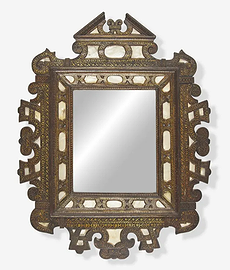
M-64
Late Part 16th Century Venetian Mother-of-Pearl Inlaid and Parcel Gilt Lacquered Mirror
Late Part 16th Century Venetian Mother-of-Pearl Inlaid and Parcel Gilt Lacquered Mirror. Compose of later part elements Provenance: Estate of Aline Thorold (1869-1951) Provenance: Aline Thorold (1869-1951) m. Ernest James Wythes (1868-1949) at Copped Hall, Essex, until 1917 and The Wood House, Essex, thereafter and by descent to Barbara Dorothy Wythes (1896-1984) m. (Francis) Guy Robert Elwes (1895-1966) at The Wood House, Essex until 1961 and Ham Spray House, Marlborough, thereafter and by descent to Aline Mary Margaret (Elwes) McDonnell (1923-2023) m. Hubert McDonnell Jr. (1919-2004), Greenwich, Connecticut, and thence by descent.
- width
- 19.5 in.
- height
- 25 in.
- condition
- Mirror plate antique but later, possibly formally a picture frame, top arch pediment mouldings replaced , back boards of the mirror plate are later, the back rectangular frame holding the mirror installed at a later date to solidify the original frame and hold the mirror plate.
-
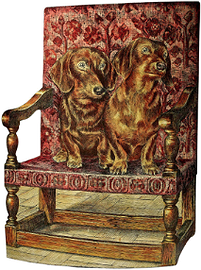
F-39
'Bassoitti' Lithographically Printed and Painted Metal Umbrella Stand by Piero Fornasetti
Bassoitti lithographically printed and painted metal umbrella stand by Piero Fornasetti for Fornasetti Milan, Italy: circa 1950
- width
- 20
- height
- 33.75 in.
- depth
- 6
-

F-38
Collie' Lithographically Printed and Painted Metal Umbrella Stand by Piero Fornasetti
Collie Lithographically Printed and Painted Metal Umbrella Stand by Piero Fornasetti for Fornasetti Milano. Italy: circa 1950
- width
- 16
- height
- 32.75 in.
- depth
- 5
-
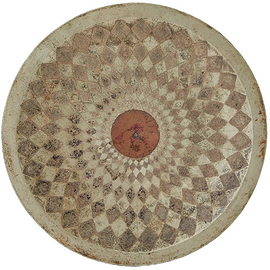
NW-38
Radiating Lozenge Pattern Copper Bowl by Claudius Linossier
Radiating lozenge pattern copper bowl by Claudius Linossier signé: CL-LINOSSIER and A 168. France: circa 1930
- diameter
- 7.5 in.
- condition
- Very good condition
-
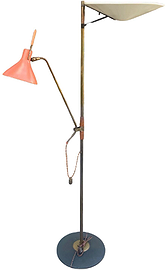
L-110
Polychrome Metal Adjustable Floor Lamp by Gerald Thurston for Lightolier
Polychrome metal floor lamp designed by Gerald Thurston for Lightolier. Includes an upward reflector and an adjustable reading lamp. USA: circa 1950
- width
- 30 in.
- height
- 68 in.
- diameter
- 14 in.
-
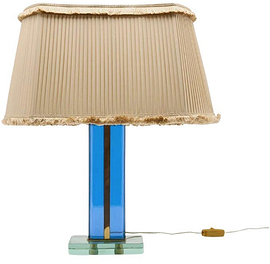
L-56
Clear Blue Glass and Brass Table Lamp by Pietro Chiesa for Fontana Arte
Clear blue glass and brass table lamp by Pietro Chiesa for Fontana Arte Italy: circa 1945 provenance: Quittenbaum, Art Nouveau - Art Deco, Munich, 9 December 2015, Lot 44
- width
- 20.75 in.
- height
- 20.75 in.
- depth
- 14 in.
- condition
- Very good condition , oxidation to brass was polished and varnished.
-

P-52
Oil on Canvas of Bathsheba by Émile Aubry (1880-1964)
Oil on Canvas of Bathsheba ( one of the wives of David ) by Émile Aubry (1880-1964) Signed: "Émile Aubry" France: circa 1928 Emile Aubry was born in Algeria but moved to Paris as a child. In 1904 he became the pupil of Gerome, later transferring to the atelier Carolus-Duran. Never forgetful of his childhood in North Africa, where he continued to travel, Aubry produced many orientalist works before turning to portraiture and the grand "Neo-Classical" style which became fashionable in the 1920s. picture of him painting in Ain Meddah Algéria size with frame H:75.2 W:71.25 in. Literature: Suzanne Casanova Aubry, Emile Aubry : regards de peintre, Edité à compte d’auteurs, Nice, 1997 see sketch p.97
- width
- 63.3
- height
- 67.3 in.
- depth
- 1 in.
- condition
- Original stretcher and frame with silver leaf updated, no previous restoration to the canvas.
-
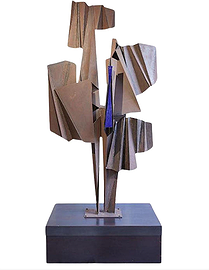
SC-80
Large Steel and Enamel Abstract Sculpture by Alan Goldstein
Large steel and enamel abstract sculpture by Alan Goldstein USA: circa: 1965 His work is represented in over 70 private collections in the United States and abroad, and he has exhibited his work at the Michener Art Museum, the Woodmere Art Museum, and Art Works in Trenton, New Jersey, among other institutions.
- width
- 36.25 in.
- height
- 85 in.
- depth
- 24.25 in.
-
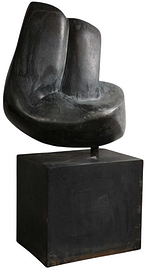
SC-79
Abstract Patinated Bronze Sculpture by Aviva Shemer
Abstract patinated bronze sculpture by Aviva Shemer resting on steel base Israel: circa 1998
- width
- 54
- height
- 70
- depth
- 29.5
-
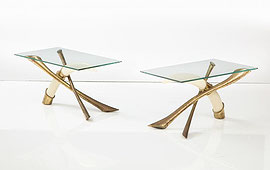
T-23
Pair of Faux Tusk and Brass Side Tables by Jacques Duval Brasseur
Pair of faux tusk and brass side tables by Jacques Duval Brasseur. France: circa 1970
- width
- 17 in.
- height
- 15.5 in.
- depth
- 28 in.
-

L-49
Leather and Oak Floor Lamp by Jacques Adnet
Leather and oak floor lamp by Jacques Adnet France: circa 1955 provenance: Galerie Yves Gastou, Paris | Private Collection, Paris | Phillips de Pury & Luxembourg, New York, Design, 11 June 2003, Lot 60 | Private Collection | Christie's, New York, Design, 9 December 2022, Lot 450 | Private Collection
- height
- 66 in.
- diameter
- 19.5 in.
- condition
- Very good condition, original leather.
-

C-34
$175,000
Rare "Chan Li" Cabinet by Philip & Kelvin Laverne
Rare engraved and acid-etched, patinated and polychromed bronze, pewter and enamel "Chan Li" Cabinet resting on Greek Key form base by Philip & Kelvin Laverne. The sides and top engraved in the Kuan pattern of interlocking circles which is meant to evoke "something from the past". The interior featuring shelves and a drawer with Kuan pattern front and fish shaped pull. The base Incised: Philip and Kelvin LaVerne 1978. USA: 1978 Literature: Philip and Kelvin LaVerne: Sculpture III, studio catalogue, Philip LaVerne Galleries Ltd., New York, n.d., pp. 3, 50. Alchemy, The Art of Philip and Kelvin Laverne, by Evan Lobel, p.29, 51, 77, T. Merrill and J. V. Iovine, eds., Modern Americana: Studio Furniture from High Craft to High Glam, New York, 2008, pp. 158-159 (for a related example)
- width
- 49 in.
- height
- 31.25 in.
- depth
- 15.5 in.
- condition
- Very good original condition.
-
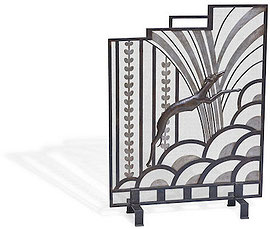
F-37
Art Deco Wrought Iron Fire and Steel Screen Decorated with a Greyhound
Art Deco wrought iron and steel fire screen decorated with a Greyhound France: circa 1940
- width
- 29.5
- height
- 39.5
-
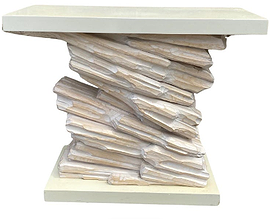
T-17
on hold
White lacquered and carved wood console table in the manner of Serge Roche
White lacquered and carved wood console table in the manner of Serge Roche, the rock form base cared out of a solid block of maple finished with a white wash, the top and base made of lacquered wood. France: circa 1970
- width
- 42 in.
- height
- 34.25
- depth
- 16 in.
-
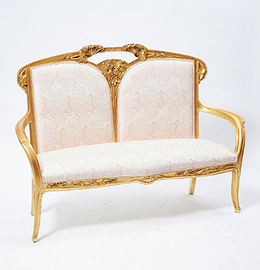
S-134
Gilt Wood Art Nouveau Period Settee by Louis Majorelle
Gilt wood Art Nouveau period settee with japanese floral details by Louis Majorelle France circa 1890 Ex Collection of Sir Rod Stewart, Los Angeles Sotheby's, New York, "20th Century Decorative Works of Art", November 17, 1988, Lot 580
- width
- 62 in.
- height
- 43.75 in.
- depth
- 22 in.
-
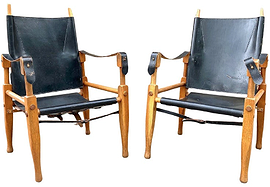
S-127
Pair of Black Leather and Oak Wilhelm Kienzle Safari Chairs
Pair of Black Leather and Oak Wilhelm Kienzle Safari Chairs Switzerland: circa 1950 seat height 14 in.
- width
- 21.5
- height
- 35.5
- depth
- 21.5
-
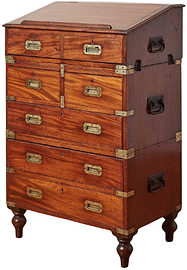
C-33
Brass-Bound Mahogany Campaign Secretary Chest of Drawers
Brass-Bound Mahogany Campaign Secretary / Chest of Drawers Provenance: The Dalva Brothers Collection
- width
- 31
- height
- 48
- depth
- 20
-
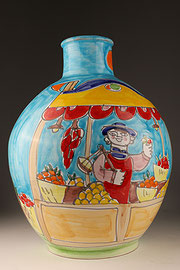
CR-32
Whimsical Ceramic Vase by Musa
Whimsical Sicilian ceramic vase by Musa showing sicilian merchants. Italy: circa 1970
- height
- 17 in.
- diameter
- 11 in.
-

M-61
Shagreen Framed Mirror by R & Y Augousti
Ria and Yiouri Augousti Taupe Shagreen Ray Skin Frame Mirror. Beveled glass mirror with original tag on verso. France: circa 1980
- width
- 27.5 in
- height
- 35.5 in
-
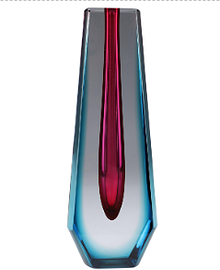
GL-09
Bohemian Czech "Sommerso" Glass Vase by Pavel Hlava
Bohemian "Sommerso" glass vase by Pavel Hlava Marked on underside. Czech Republic circa: 1960
- width
- 3 in.
- height
- 8.5 in.
- depth
- 1.75 in.
-
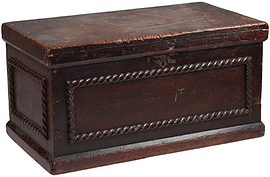
C-13
on hold
Victorian Faux Mahogany Finish Pine Trunk
Victorian Faux Mahogany Finish Pine Trunk Canada: circa 1850
- width
- 25 in.
- height
- 12.75 in.
- depth
- 14 in.
-

S-119
Pair of Art Deco Macassar Ebony Armchairs By Maison Dominique
Pair of Art Deco Macassar ebony armchairs by André Domin et Marcel Genevriève for Maison Dominique France: circa 1940 seat height 20 1/2 in
- width
- 21.5
- height
- 42 in.
- depth
- 22.5
- condition
- Very good overall condition, no restorations noted, re-upholstered at some point.